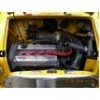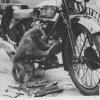Mig Welds
#1

Posted 02 April 2014 - 06:44 AM
#2

Posted 02 April 2014 - 07:43 AM
They are looking very good for a 1st start, I wish mine were that good at the beginning (many years ago now).
To reduce the blobs maybe try slowing down your wire feed some more, it's dependent on the welder but I find that for thin material somewhere closer to 2 to 4 works best.
The best bit of advice I ever received regrading mig welding was that the weld should sound like an egg frying in a hot pan .... once you get to that level you will see what I mean...it's a hissing type noise.
Last bit is on cleaning the material you are mig'ing, the cleaner the better the weld and penetration.
#3

Posted 02 April 2014 - 06:59 PM
All (or most) of those welds look 'bubbly'. That's typically low/no gas (or a disturbed shroud) or contamination. They also look very 'proud' of the surface suggesting either you're moving too slowly and/or your penetration is poor.
Don't make your life more difficult than it needs to be - make sure you are welding on clean metal, really clean.
Have a good look through:
http://www.mig-weldi...uk/tutorial.htm
...and watch the videos. For welding panels I'd recommend paying attention to the 'Thin Metal' technique here:
http://www.mig-weldi...-techniques.htm
....as it really works very well.
As it stands, and I don't want to put a downer on it, I wouldn't go near a car with those welds. You need to get some practise in (and that's all it'll take) before taking on any serious repairs or you'll just kick yourself later when you look back! (I do it all the time looking back at some of my old work).
Edited by Icey, 02 April 2014 - 07:07 PM.
#4

Posted 02 April 2014 - 07:00 PM
#5

Posted 03 April 2014 - 02:05 AM
Your welds should look like a worm that has melted a bit, so the edges flow out. Not like a round on top of the metal where the side go in under the bead.
There should not be all of those pin holes in the weld either. That is usually from contamination in the weld burning and boiling off.
Sheet metal is thin and hard to weld once you have 2 pieces to join. Sheet metal is usually welded at the lowest heat setting and about the mid or slightly slower wire speed. To join to pieces you will not be trying to run a seam, but stitch the join with many, many little weld beats. Just like tacking it but along the line to be joined. Tack, move an inch or more, tack, move, tack, move. This keeps the weld from overheating and blowing out. Once you have the seam fully tacked up and closed, go back and grind the weld down and fill in any holes. Tedious but effective.
To practice and get good welds right away, use some old angle iron. It's thicker and you can run a continuous bead on it without blowing thru.
Good luck!
#6

Posted 03 April 2014 - 02:33 AM
All (or most) of those welds look 'bubbly'. That's typically low/no gas (or a disturbed shroud) or contamination. They also look very 'proud' of the surface suggesting either you're moving too slowly and/or your penetration is poor.
Don't make your life more difficult than it needs to be - make sure you are welding on clean metal, really clean.
Have a good look through:
http://www.mig-weldi...uk/tutorial.htm
...and watch the videos. For welding panels I'd recommend paying attention to the 'Thin Metal' technique here:
http://www.mig-weldi...-techniques.htm
....as it really works very well.
As it stands, and I don't want to put a downer on it, I wouldn't go near a car with those welds. You need to get some practise in (and that's all it'll take) before taking on any serious repairs or you'll just kick yourself later when you look back! (I do it all the time looking back at some of my old work).
Excellent summary, particularly shield gas and cleanliness.
There is a lot to be said to practicing on thicker plate lap joints first, seeing how the wire feed and power effect penetration, and slowly reducing the plate thickness.
No detriment to the OP, but everyone become a welder with a MIG set..... get used to stick and gas to see how metal behaves.
1 user(s) are reading this topic
0 members, 1 guests, 0 anonymous users

















